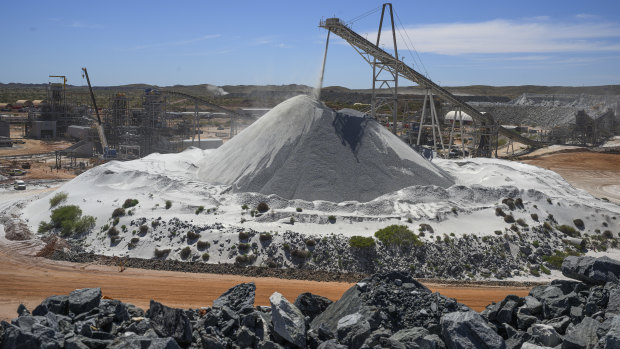By Shane Wright
The federal government and its $23 billion Future Made in Australia policy have been put on notice by the Productivity Commission, which has urged caution spending so much money on a program that may not play to Australia’s traditional economic advantages.
In its annual review of handouts to businesses and industries, the commission also revealed a 300 per cent blowout in a COVID-era policy that contributed to some of the cost pressures across the building sector.

The Future Made in Australia policy is aimed at supporting new industries in areas such as lithium processing.Credit: The New York Times
Every year, the commission reports on the amount of assistance paid to industry – either directly or through tax concessions – by the government. The programs stretch from research and development allowances to the Farm Management Deposit Scheme available to primary producers.
Total assistance to business and industry edged down in 2022-23 to $15 billion from $15.2 billion the previous year. The drop was largely due to the discontinuation of COVID-era programs.
Of the $11.6 billion that could be attributed to specific sectors, the commission estimated $1.9 billion went to financial and insurance services businesses, $1.7 billion went to professional and scientific services, and $1.6 billion to the farm sector.
The commission’s work did not include the Future Made in Australia package that was the centrepiece of the May budget and which the government is planning to use to boost development across manufacturing and energy.
But it did find programs like it have become the go-to policy lever of governments around the world, with 1800 separate measures put in place by other administrations in 2023.
Already there have been substantial cost blowouts with these programs. The Biden administration’s Inflation Reduction Act has driven $US110 billion ($167 billion) in new investment since its inception, including $US70 billion in the electric-vehicle supply chain.
But the cost of the act to the US budget is now on track to top $US800 billion over the next decade.
The Future Made in Australia policy will use production credits through the tax system to encourage businesses.
Productivity Commission deputy chair Alex Robson cautioned that any government support for an industry had to be carefully considered and take into account the nation’s natural economic strengths.
“A strong economy is one that makes the most of its relative strengths – but identifying points of comparative advantage is not straightforward,” he said.
“Governments should be cautious in pursuing industry policy on this basis and build in off-ramps to allow a timely exit if these policies fail to achieve their stated aims.”
The commission found Australia’s most competitive economic sectors were mining and agriculture.
While the Future Made in Australia policy will support elements of the mining sector, the government is also using it to support green hydrogen, the processing of critical minerals and the development of quantum computing.
Treasurer Jim Chalmers said the report, which highlighted the government’s decision to axe almost 500 nuisance tariffs from July 1, showed the importance of using public money wisely.
“The global energy transformation represents a golden opportunity for Australia – and the PC’s report supports our vision to capitalise on our unique natural strengths to help Australian workers and businesses prosper,” he said.
“The report highlights that, as economies decarbonise, Australia’s comparative advantages will shift alongside our access to low-cost renewable energy – our Future Made in Australia plan will seize these opportunities.”
Robson said any government spending had to be both well-articulated and subject to rigorous public cost-benefit analysis.
“Policy discipline will ensure industry assistance is focused on achieving clear goals at least cost to the Australian community, without inadvertently becoming a new form of trade protectionism,” he said.
While the commission found the overall amount of government support for business is falling, it noted the HomeBuilder program, a scheme put in place by the Morrison government in 2020, continues to soar.
HomeBuilder provided $25,000 grants to people seeking to build a new home or substantially renovate an existing property. The government at the time claimed it was necessary to support the construction sector, which was expected to struggle due to the pandemic.
Slated to cost just $680 million, then-treasurer Josh Frydenberg said the scheme – which closed to new applicants in April 2021 – would “support” up to 1 million jobs.
The commission found the scheme has already cost $2.7 billion, with the Albanese government giving existing applicants until the middle of next year to complete their submissions. HomeBuilder now accounts for almost all of the COVID-era assistance still flowing through the economy.
Treasury documents released under freedom of information last year revealed work done for the department showed HomeBuilder had partially contributed to the “constraints in supply of labour, materials and land that resulted from this industry overheating”.
Cut through the noise of federal politics with news, views and expert analysis. Subscribers can sign up to our weekly Inside Politics newsletter.